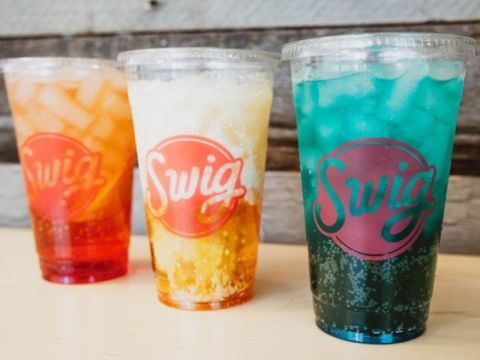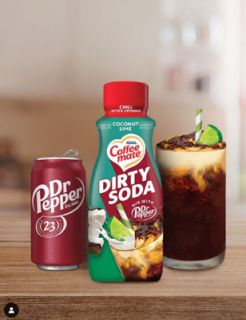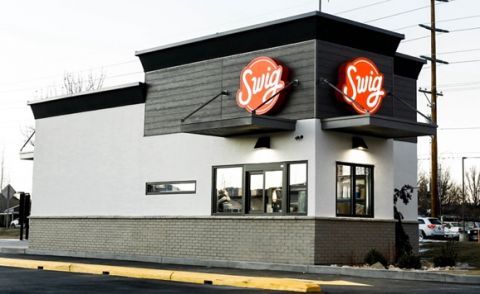
Vol. XXIV, No. 7, November 2024
The rise of dirty soda
Here's a riddle for you: If socialization revolves around food and drink, but your religion bans alcohol and coffee, what do you do? The answer: Get dirty!

Dirty soda sounds pretty risqué for a conservative group like the Church of Jesus Christ of Latter-Day Saints (the Mormons). Still, the drinks themselves are a result of the Mormon tenets on clean living (the Word of Wisdom), which forbids alcohol or "hot drinks." Coffee (of any temperature) is out, and even herbal teas are iffy, but thankfully, as of 2012, the LDS Church ruled that caffeine is OK. Amidst these restrictions, soda became an obvious beverage choice for observant Mormons. But it would be hard to avoid feeling left out when comparing soda options against the overwhelming choices afforded to thirsty customers at bars and coffee shops. Such was the situation for Nicole Tanner, a Mormon mother of five who founded Swig, the first dirty soda drive-thru shop, in April 2010.
You're probably familiar with a dirty martini (with olive juice) or even a dirty Chai (with a shot of espresso), but what makes a soda "dirty"? Dirty sodas are similar to Italian sodas, sweetened with various flavored syrups, fruit purees, and creamer. But instead of a base of seltzer, a dirty soda starts with a standard-brand soda, such as Coke/Pepsi, diet, cola, or Dr. Pepper. Some popular dirty sodas include:
- The Founder: Diet Coke, heavy cream, coconut syrup, lime juice - the original dirty soda
- The Happy Camper: Root beer, toasted marshmallow syrup and half-and-half
- Island Time: Fresca with passion fruit syrup, mango puree, coconut cream, and a wedge of fresh orange - a favorite among Mormon models and influencers
- Dr Spice: Dr. Pepper, cinnamon and coconut syrups, half & half, and a cinnamon stick - aSwig seasonal favorite

Dirty sodas may have remained a quirky, regional specialty if not for
TikTok. However, in late 2021, Gen Z musician Olivia Rodrigo posted a photo
with her drink from Swig. In April 2022, TikTok had accrued over 700,000
mentions of #dirtysoda. Since then, dirty sodas have gone mainstream. Sonic
has a line of dirty drinks, and Coffee Mate has launched a dirty soda
coconut lime creamer. Swig, which had 61 locations across eight states at
the beginning of the year, recently announced plans to open 250 more
 locations across seven new states, some opening as early as the end of this
year. And other dirty soda shops are popping up, including Thirst, FiiZ,
Sodalicious, and QuenchIt! FiiZ has over 60 stores, and Sodalicious has
25. Thirst recently opened its seventh location at Salt Lake City airport.
locations across seven new states, some opening as early as the end of this
year. And other dirty soda shops are popping up, including Thirst, FiiZ,
Sodalicious, and QuenchIt! FiiZ has over 60 stores, and Sodalicious has
25. Thirst recently opened its seventh location at Salt Lake City airport.
It is not surprising that non-alcoholic drinks like dirty sodas are taking off. It is even less surprising that Gen Z is leading it. As we have discussed in earlier issues of this newsletter, there has been a growing interest in low-alcohol/no-alcohol beverages, and Gen Z is at the forefront of the movement.
But how do they taste?
Adding dairy to soda may seem strange to the American palette, but it isn't a new concept. Similar drinks can be found in South Asia and Korea. The all-American soda fountain traditionally served Italian sodas (seltzer/flavored syrup and cream) and egg creams (seltzer, chocolate syrup, and cream). And, of course, who doesn't love a good root beer float?
Intrigued? Why not give it a try? Chances are there will soon be a dirty soda shop near you.
Dirty sodas make a great addition to the beverage menu for any location-based entertainment venue (LBE). They not only satisfy the need for non-alcoholic drinks but are also very profitable.
Here's a breakdown of the components and estimated costs for a dirty soda:
- Base Soda - A standard 20 oz fountain soda costs businesses around $0.10-$0.20.
- Flavored Syrups - Syrup costs vary but typically range from $0.05-$0.15 per pump.
- Cream or Milk - A splash of cream or milk (1-2 oz) costs approximately $0.10-$0.20.
- Additional Toppings - Optional toppings like whipped cream, fruit purees, or gummies may add $0.10-$0.30.
A typical dirty soda might include:
- Base soda: $0.15
- 2-3 pumps of syrup: $0.20
- Cream/milk: $0.15
- Optional topping: $0.20
Total estimated COGS: $0.50-$0.70 per drink.
Dirty sodas are often priced between $3-$5, depending on size and customizations. Using an average price of $4:
- COGS: $0.70 (high estimate)
- Revenue: $4.00
- Gross profit: $3.30
- COGS: 17.5%
- Gross margin: 82.5%
Take away
Dirty sodas make a great addition to the beverage menu for any location-based entertainment venue (LBE), including family entertainment centers (FEC). They not only satisfy the need for non-alcoholic drinks but are also very profitable. They also offer the option to create LTOs (limited-time offerings) to help drive repeat business.
Subscribe to monthly Leisure eNewsletter


